HMS Devonshire was the first of the County-class destroyers and the first Batch 1 ship of the Royal Navy. The ship was built by Cammell Laird in Birkenhead near Liverpool. With a displacement of 5,440 tonnes, Devonshire was named after the English county of Devon. She was launched on 10 June 1960 and delivered to the navy two years later.

HMS Galatea (F18) was a Leander-class frigate of the Royal Navy. She was built by Swan Hunter & Wigham on the Tyne. She was launched on 23 May 1963 and commissioned on 25 April 1964 and was the 8th ship of the Royal Navy to bear the name.

HMS Naiad (F39) was a Leander-class frigate of the Royal Navy (RN). Like the rest of the class, Naiad was named after a figure or figures of mythology, in this case the Naiads of Greek mythology. Naiad was built by Yarrow Shipbuilders of Scotstoun. She was launched on 4 November 1963 and commissioned on 15 March 1965.

HMS Arethusa was a Leander-class frigate of the Royal Navy. She was, like most of the Leanders, named after a figure of mythology. Arethusa was built by J.S. White & Company Shipbuilders of Cowes, launched on 5 November 1963 and commissioned on 24 November 1965.
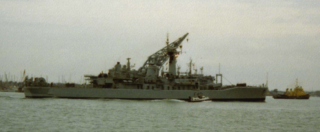
HMS Sirius (F40) was a Leander-class frigate of the Royal Navy (RN) built by H.M. Dockyard Portsmouth, and was the penultimate RN warship to be built there for a period of forty years, until Vosper Thornycroft built HMS Clyde. Sirius was launched on 22 September 1964 and commissioned on 15 June 1966. The ship continued in front line service until February 1992.

HMS Duncan was the fifth RN ship named after Admiral Adam Duncan. She was a Blackwood-class frigate of the Royal Navy that served in the Cod Wars.

HMS Grampus (S04) was a Porpoise-class submarine. Her keel was laid down in 1955 by Cammell Laird at Birkenhead. She was launched by Lady Shepheard on 30 May 1957. She was first commissioned on 19 December 1958.

HMS Hardy was an anti-submarine warfare frigate of the Blackwood class or Type 14. She was named after Thomas Masterman Hardy, Captain of HMS Victory at Trafalgar. Hardy was the first Type 14 frigate built, completed on 8 December 1955, by Yarrow Shipbuilders.

HMS Tireless, a Taciturn- or T-class submarine, was the first ship of the Royal Navy to bear that name. She was authorized under the 1941 War Emergency Program and her keel was laid down on 30 October 1941 at Portsmouth Dockyard. She was launched on 19 March 1943 and was completed on 18 April 1945.

HMS Dundas was a Blackwood-class anti-submarine warfare frigate of the Royal Navy.
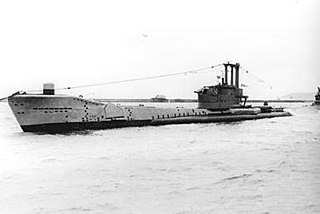
HMS Alderney (P416), was an Amphion-class submarine of the Royal Navy, built by Vickers-Armstrongs at Barrow and launched 25 June 1945 by Mrs Molly Wallis, wife of Sir Barnes Wallis. She was the 12th of the class and was scrapped in 1972.

HMS Artful (P456), was an Amphion-class submarine of the Royal Navy, built by Scotts Shipbuilding and Engineering Company of Greenock and launched 22 May 1944.

HMS Russell was one of a dozen Blackwood-class frigates of second-rate anti-submarine frigates built for the British Royal Navy during the 1950s. She was named for Edward Russell, 1st Earl of Orford, commander at the Battle of Barfleur in 1692.
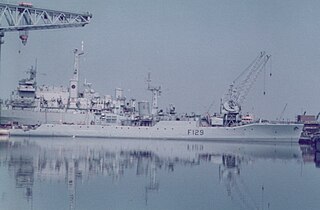
HMS Rhyl was a Rothesay-class or Type 12I anti-submarine frigate of the Royal Navy, launched by Lady Macmillan on 23 February 1959 and commissioned in October 1960. Following Royal Navy service she was sunk as a target in 1985.
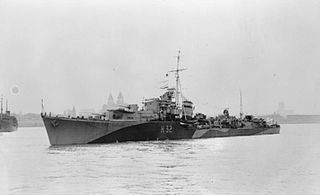
HMS Rapid was an R-class destroyer of the Royal Navy that saw service during the Second World War and was sunk as a target in 1981.

HMS Wakeful was a W-class destroyer of the Royal Navy launched in 1943. She saw service during the Second World War and was later converted into a Type 15 fast anti-submarine frigate. She was sold for scrap in 1971.
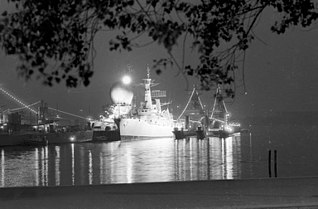
HMS Walrus (S08) was the last of the Porpoise class submarines of the Royal Navy. She was launched on 22 September 1959, and commissioned on 10 February 1961.

HMS Tiptoe was a British submarine of the third group of the T class. She was built by Vickers Armstrong, Barrow, and launched on 25 February 1944. She was one of two submarines named by Winston Churchill, and so far has been the only ship of the Royal Navy to be named Tiptoe. In 1955 she was involved in a collision with a coastal steamer whilst in Tromsø harbour. She was involved in escape trials off Malta in 1962, and the commanding officer was reprimanded in 1964 following an incident in the Firth of Clyde where she was run aground, and again in 1965 when she collided with HMS Yarmouth. Although originally named for the ability to sneak up on someone undetected, she maintained several links with ballet, including the Royal Ballet and ballet dancer Moira Shearer. She was scrapped at Portsmouth in 1975, while her anchor is on display in Blyth, Northumberland.

HMS Token was a British submarine of the third group of the T class. She was built as P328 at Portsmouth Dockyard, and launched on 19 March 1943. So far she has been the only ship of the Royal Navy to bear the name Token.

HMS Talent was a British submarine of the third group of the T class. She was built as P337(S37) by Vickers Armstrong, Barrow, and launched on 13 February 1945. She was originally to have been named HMS Tasman, but was this was changed to Talent after the previous HMS Talent was transferred to the Royal Netherlands Navy.



















